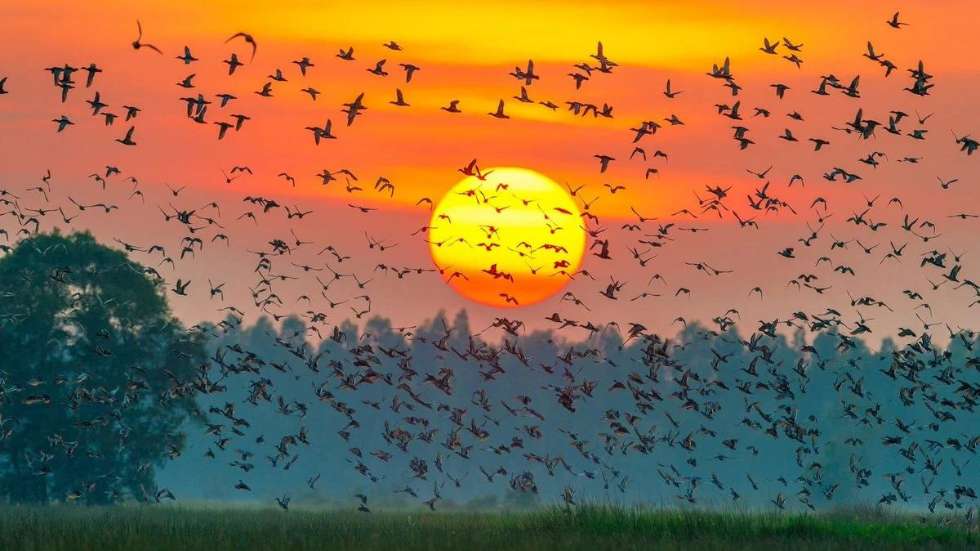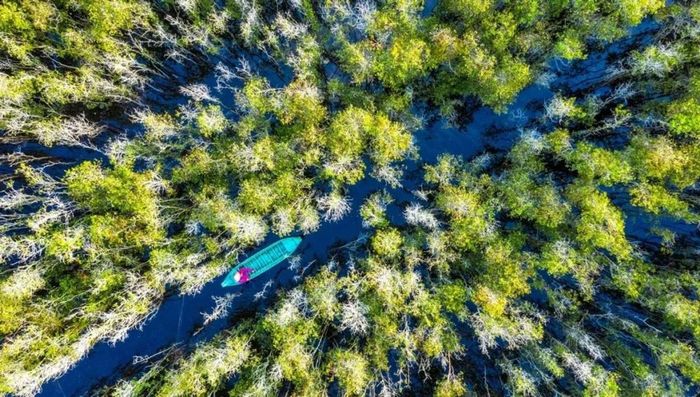Vietnam is famous for many breathtaking national parks, each with its own ecosystem. Among all of them, Tram Chim National Park stands out with its unique wetland geography and its bird species. Visiting this park will definitely be a satisfying trip for bird lovers, photographers, biologists, or simply any adventurous travelers who want to move away from the crowd for an authentic experience.

- Address: Group 4, Tam Nong District, Plain of Reeds, Mekong Delta Region, Vietnam
- Entrance ticket fee: 20,000VND ($1) for adults; Free for children under 1.4m tall (not including boat rent fee)
- Opening hours: 7 AM – 5 PM
- Phone number: 0277 3827 307
Tram Chim National Park, located 40km from Cao Lanh City, Dong Thap Province, was once a degraded wetland in Vietnam. It was restored to protect several rare bird species, especially the Sarus crane (red-headed crane), and officially lifted to became a national park in 1998. Nowadays, the park is approximately 75,88 square kilometers wide, home to a number of rare birds, fish, and aquatic plants, many of which are on the verge of extinction.
>>> Read more: Mekong Delta Itinerary: Unforgettable Experiences in Vietnam’s Heartland
2. What Makes Tram Chim National Park So Special?
Topography and Hydrology
The Tram Chim National Park has a unique geography compared to other national parks in Vietnam. It is located 19km east of the Mekong Delta River, with a flat surface, and slopes slightly to the east. In the past, several natural streams flowed from the Mekong River to the park, but now they have been replaced with a system of canals. Therefore, the park is now flooded less than 6 months per year, with the water levels starting to rise in June, at the beginning of the rainy season. The flood is higher from September to December, from 2 meters to 4 meters, and it peaked in October.
Biodiversity
The Tram Chim National Park has an extremely valuable ecosystem. It is divided into 5 grassland communities, with the 2 most important areas filled with Chinese water chestnut and wild rice. In this park, visitors can witness up to 147 water bird species, with 13 rare ones, most notably the red-headed cranes. Other than that, the park is also home to 130 high-quality plant species, 130 species of freshwater fish, 185 species of phytoplankton, 93 species of xooplankton, and 90 species of zoobenthos.
3. Must Do Activities at Tram Chim National Park
Birdwatching & Photography
 Tram Chim National Park is most famous for its diverse habitat of birds, so birdwatching and photography here is a must! The redhead cranes, which are in both Vietnam’s red data book and the IUCN red list, mainly live in Cambodia and only migrate to this park during the dry season, so it’s ideal to come here from December to April. Other than that, the park is also famous for the Asian open bill stock (co oc), and many other species, including storks, snakebirds, gray herons, and grey-headed swamp hens, creating a tranquil natural picture.
Tram Chim National Park is most famous for its diverse habitat of birds, so birdwatching and photography here is a must! The redhead cranes, which are in both Vietnam’s red data book and the IUCN red list, mainly live in Cambodia and only migrate to this park during the dry season, so it’s ideal to come here from December to April. Other than that, the park is also famous for the Asian open bill stock (co oc), and many other species, including storks, snakebirds, gray herons, and grey-headed swamp hens, creating a tranquil natural picture.
Ride a Boat
 Boats are the main mode of transport in Tram Chim National Park. Visitors can rent a motorboat or paddleboat to travel around the park. For paddle boats, there are 2 possible routes: the Nang Ong route for 12km at 700,000VND ($30), and the Ca Na route for 21km at 1,000,000VND ($50). Enjoy a day like a local fisherman, paddling through the canals, setting nets, traps, and fishing; or you can travel like a farmer and go rice or water lilies harvest.
Boats are the main mode of transport in Tram Chim National Park. Visitors can rent a motorboat or paddleboat to travel around the park. For paddle boats, there are 2 possible routes: the Nang Ong route for 12km at 700,000VND ($30), and the Ca Na route for 21km at 1,000,000VND ($50). Enjoy a day like a local fisherman, paddling through the canals, setting nets, traps, and fishing; or you can travel like a farmer and go rice or water lilies harvest.
Enjoy local dishes
 Coming here, tourists have 2 dining options: dining directly on a boat or visiting the Quan Tourist Restaurant right outside the park. Tram Chim National Park offers a lot of fresh ingredients for the Mekong Delta traditional cuisine, so it will not disappoint adventurous travelers. Some notable dishes here are grilled snakehead fish wrapped in lotus leaves, roasted field mouse, tram leaf grilled chickens, steamed snails with fresh peppercorns, crab hotpots, eels cooked with lemongrass, dried snakehead, and fried fish paste.
Check out more about the Mekong Delta Food here!
Coming here, tourists have 2 dining options: dining directly on a boat or visiting the Quan Tourist Restaurant right outside the park. Tram Chim National Park offers a lot of fresh ingredients for the Mekong Delta traditional cuisine, so it will not disappoint adventurous travelers. Some notable dishes here are grilled snakehead fish wrapped in lotus leaves, roasted field mouse, tram leaf grilled chickens, steamed snails with fresh peppercorns, crab hotpots, eels cooked with lemongrass, dried snakehead, and fried fish paste.
Check out more about the Mekong Delta Food here!
4. When to Visit Tram Chim National Park

Overview of Tram Chim National Park’s Weather
The Tram Chim National Park has an average temperature of 27 °C all year, and it is a little lower from December to February. The region has only 2 seasons: the rainy season from May to November and the dry season from December to April.
Floating season
The floating season in Tram Chim National Park lasts from October to January. It is the most suitable season for rowing boats around the park when the natural landscape and ecosystem are at their peak. The park is surrounded by lush greenery, from lotus flowers to water lilies. Tourists can participate in harvesting water lilies or floating rice.
Dry season
The dry season is the peak season in Tram Chim National Park, ranging from December to April. In this season, the sky is extremely clear, so guests can have the best birdwatching experience. This is also when the red-headed cranes come back to the park after months of migrating from the flood. This is because, unlike other birds in the field, red-headed cranes tend to find food on dry ground, so visitors can only see them during this season.
Different flower season
Tram Chim National Park is the perfect spot for flora and fauna enthusiasts with various flower seasons. Besides the water lilies in the floating season, guests can also visit the red-headed crane flower from February to May, or the violet Melaleuca flower from May to April.
5. Travel Tips to Tram Chim National Park

- Check the weather: Since the weather in the Mekong Delta region can be diverse, guests should check the weather forecasts before visiting the park.
- Get a local guide: The park is extremely vast, with a complex system of areas and routes. Therefore, it is advised that tourists should get a local guide to not getting lost.
- How to get there? The park is located 145km from Ho Chi Minh City. Tourists can fly to Tan Son Nhat Airport, then travel there by bus or hire a private vehicle.
- What to wear? Visitors should wear comfortable clothes and sturdy footwear, preferably sandals, flip-flops, or plastic boots, to walk through the mud and water. It is best to wear green-colored clothes so that you can blend into the surroundings and not scare away the birds. Prepare a swimsuit if you want to go for a dive too.
- What to bring? Some other gear that travelers should bring along is insect repellent, rain gear, hats, and sunscreen. Bring some binoculars and cameras if you want to go birdwatching or photographing.
- Where to stay? For an overnight stay inside the park, Tram Chim Homestay is a great choice. A room can range from 150,000VND to 300,000VND ($7 to $11). The homestay is located at 4 Tram Chim, Tam Nong District.
Read more: Best Things to Do in Vietnam: Top Attractions and Hidden Gems
Conclusion
Tram Chim National Park may be a lot quieter among the tourist community, but it is surely a hidden gem of the Mekong Delta region. With its breathtaking landscapes, diverse wildlife, and unique wetland ecosystem, the park offers an unforgettable and affordable experience for nature lovers and travelers.
Looking to explore more of the Mekong Delta after visiting Tram Chim National Park? YESD’s
Mekong Delta tours offer an immersive, ethical travel experience that goes beyond the typical itinerary. With YESD, you’ll journey deeper into local life, learning traditional crafts, and engaging in authentic cultural exchanges. Our tours are designed with sustainability at the core, meaning your trip directly supports the communities you visit. Choose YESD for a responsible, authentic, and translated Vietnam adventure.
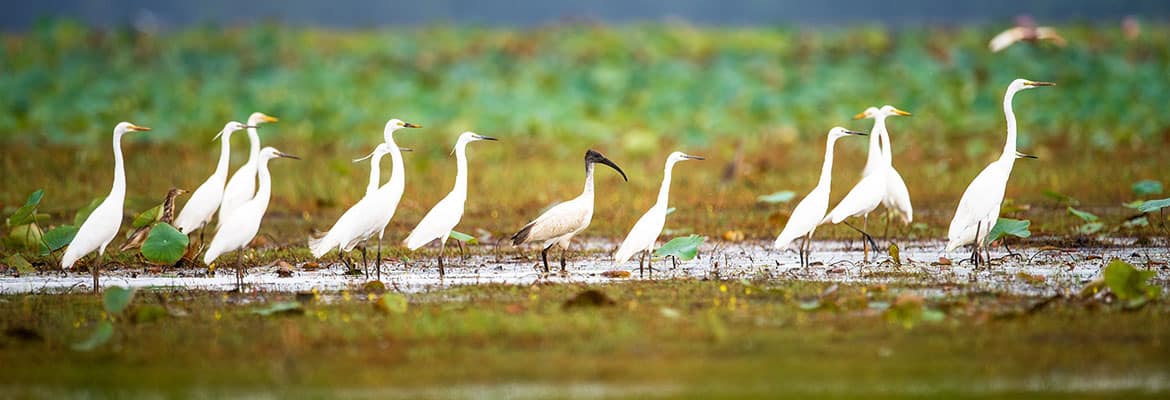
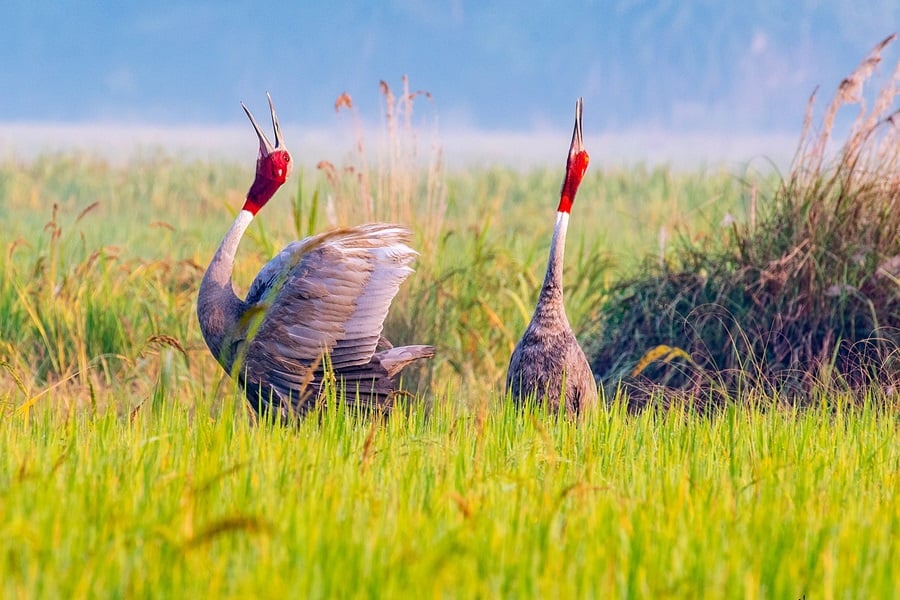 Tram Chim National Park is most famous for its diverse habitat of birds, so birdwatching and photography here is a must! The redhead cranes, which are in both Vietnam’s red data book and the IUCN red list, mainly live in Cambodia and only migrate to this park during the dry season, so it’s ideal to come here from December to April. Other than that, the park is also famous for the Asian open bill stock (co oc), and many other species, including storks, snakebirds, gray herons, and grey-headed swamp hens, creating a tranquil natural picture.
Tram Chim National Park is most famous for its diverse habitat of birds, so birdwatching and photography here is a must! The redhead cranes, which are in both Vietnam’s red data book and the IUCN red list, mainly live in Cambodia and only migrate to this park during the dry season, so it’s ideal to come here from December to April. Other than that, the park is also famous for the Asian open bill stock (co oc), and many other species, including storks, snakebirds, gray herons, and grey-headed swamp hens, creating a tranquil natural picture.
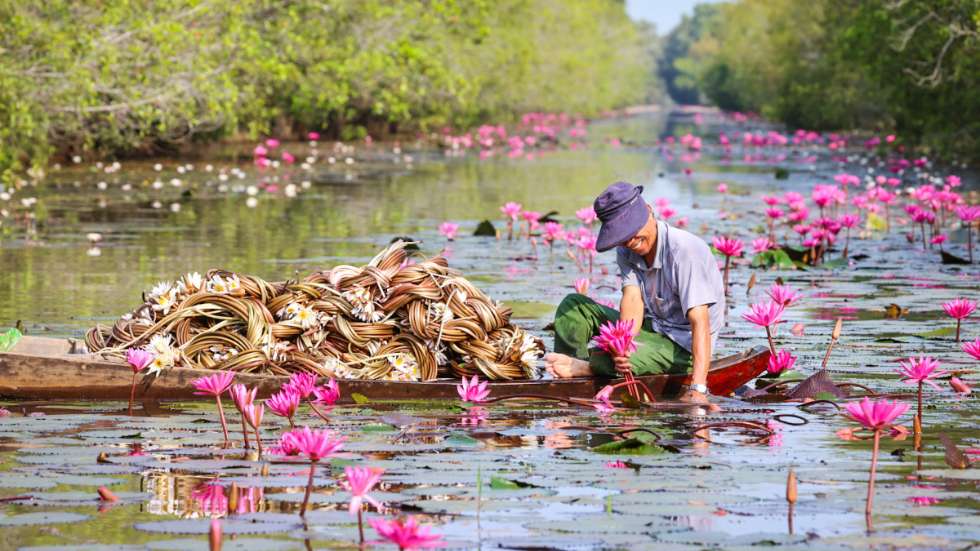 Boats are the main mode of transport in Tram Chim National Park. Visitors can rent a motorboat or paddleboat to travel around the park. For paddle boats, there are 2 possible routes: the Nang Ong route for 12km at 700,000VND ($30), and the Ca Na route for 21km at 1,000,000VND ($50). Enjoy a day like a local fisherman, paddling through the canals, setting nets, traps, and fishing; or you can travel like a farmer and go rice or water lilies harvest.
Boats are the main mode of transport in Tram Chim National Park. Visitors can rent a motorboat or paddleboat to travel around the park. For paddle boats, there are 2 possible routes: the Nang Ong route for 12km at 700,000VND ($30), and the Ca Na route for 21km at 1,000,000VND ($50). Enjoy a day like a local fisherman, paddling through the canals, setting nets, traps, and fishing; or you can travel like a farmer and go rice or water lilies harvest.
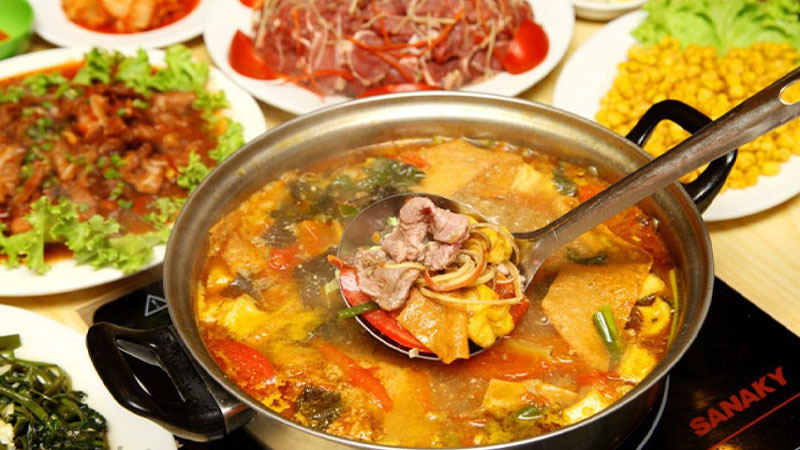 Coming here, tourists have 2 dining options: dining directly on a boat or visiting the Quan Tourist Restaurant right outside the park. Tram Chim National Park offers a lot of fresh ingredients for the Mekong Delta traditional cuisine, so it will not disappoint adventurous travelers. Some notable dishes here are grilled snakehead fish wrapped in lotus leaves, roasted field mouse, tram leaf grilled chickens, steamed snails with fresh peppercorns, crab hotpots, eels cooked with lemongrass, dried snakehead, and fried fish paste.
Check out more about the Mekong Delta Food here!
Coming here, tourists have 2 dining options: dining directly on a boat or visiting the Quan Tourist Restaurant right outside the park. Tram Chim National Park offers a lot of fresh ingredients for the Mekong Delta traditional cuisine, so it will not disappoint adventurous travelers. Some notable dishes here are grilled snakehead fish wrapped in lotus leaves, roasted field mouse, tram leaf grilled chickens, steamed snails with fresh peppercorns, crab hotpots, eels cooked with lemongrass, dried snakehead, and fried fish paste.
Check out more about the Mekong Delta Food here!
